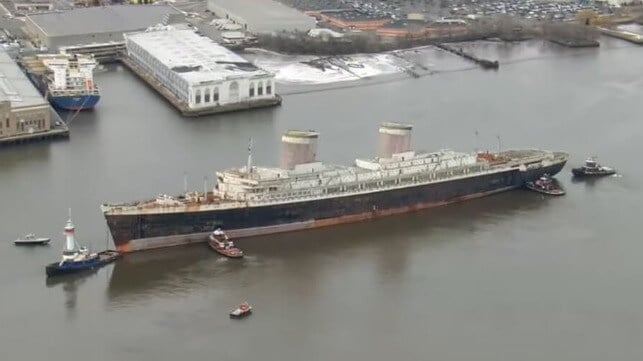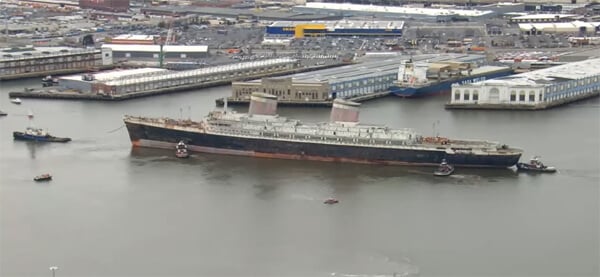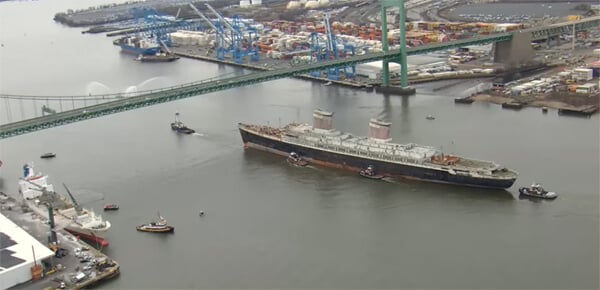Video: Liner S.S. United States Departs Philadelphia Starting Final Voyage

After many months of delays, the famed ocean liner s.s. United States departed her Philadelphia berth at midday on Wednesday, February 19. It is the first step on her final journey to becoming the world’s largest artificial reef sunk off the coast of Florida, and it drew wide attention from onlookers.
The ocean liner which still holds the title from 1952 of the fastest large passenger ship to cross the Atlantic had become a fixture on the Delaware River. She docked in an industrial part of the Port of Philadelphia in 1998. She was returning from Turkey and Ukraine where her interiors had been stripped to prepare for a possible new career as a cruise ship which never proceeded. For the past decade, the non-profit S.S. United States Conservancy sought to repurpose the vessel but in the end, was forced to sell the ship after losing a court fight with its landlord that controlled the Philadelphia pier.
Last week, the vessel was shifted north across the slipway to the adjoining pier to begin the final preparations for the tow, which was later delayed by 48 hours due to weather concerns. High wind warnings delayed the departure one final time.
At midday today, tugs positioned along the liner, pulled her out of the slip, and turned her south in the Delaware River. She paused off Pier 80 while the Vinik tug that will be taking her to Mobile, Alabama attached to the anchor chain hanging from the prow.
The trip downriver began at around 12:30 p.m. Wednesday, with two tugs on each side and one more on the stern to guide the vessel. The first obstacle was the Walt Whitman Bridge and she reached it just before low tide when the clearance under the bridge would be greatest. Road traffic on the bridge was temporarily stopped for her to pass underneath but images showed the roadway lined with vehicles from the roadway authority and personnel out watching the spectacle as the liner with its two massive funnels transited downriver and under the bridge. Reports were that she would have less than 10 feet beneath the roadway. When she arrived nearly 30 years ago, a radar antenna and a small signal light mast were removed for clearance under the bridge.
Small groups of loyal supporters of the liner and curious onlookers gathered at points along the river in both Pennsylvania and New Jersey enduring freezing air temperatures to see the unique sight of the graceful liner underway. Despite being rust streaked, peeling paint, and missing elements such as her lifeboats, she still had a majestic profile far different from the images of today’s cruise ships.

Reports are that it will take 24 hours for the tow to reach the mouth of the Delaware and enter the Atlantic Ocean. The trip to Mobile, Alabama is projected to take about two weeks and the new owners, Florida’s Okaloosa Country, arranged livestream tracking online to follow her path.
Once she reaches Mobile, the process for decontamination will continue removing PCBs, asbestos, and other harmful materials. Her fuel tanks need to be emptied of what remains from 1969 when she was last under steam in operation. The funnels, radar mast, and windows all are to be removed before the hull is reefed and the loose paint and decking materials are removed.

To many, it seems an ignominious ending to one of the most famous ocean liners. Setting the record at an average of greater than 35 knots, and rumored to be able to achieve speeds of 40 knots, she remains the fastest ocean liner ever built. At nearly 1,000 feet in length, she was sized to be able to transit the Panama Canal and had added military considerations so that she could have converted to a troopship in time of war. Her designer insisted there would be no wood in the passenger areas to make her fireproof and used only lightweight materials to reduce her weight to ensure her speed. She carried former and future U.S. president and many dignitaries, businessmen, military and government personnel, as well as regular travelers and even some immigrants during her career which numbered nearly 800 Atlantic crossings and a handful of cruises.
Competition from the jet airplane and government cost-cutting doomed the liner and in 1969 after just 17 years of commercial service her owners, United States Lines, laid up the ship. A symbol of the nation, many expected the government would relent and she would return to service. Instead, the Maritime Administration acquired her in 1973 and later sold her to a real estate developer.
A succession of owners proposed plans to reactivate the ship, or later to convert her to a static attraction. Okaloosa County acquired her for $1 million in October 2024 and expects to invest up to $10 million in the project to reef the liner, which is expected to take place in 2026.
